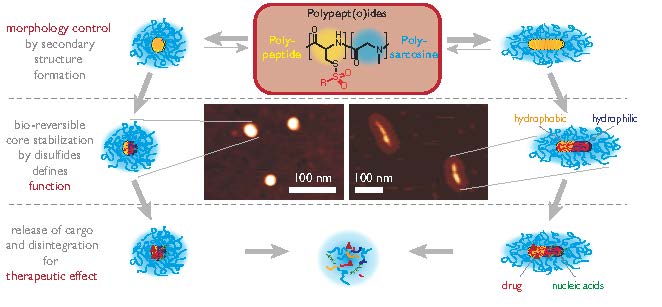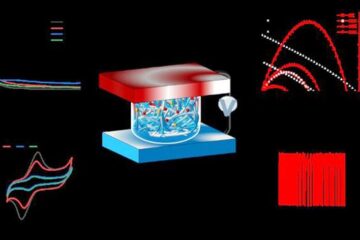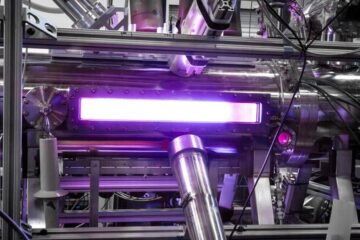Multifunctional nano-sized drug carriers based on reactive polypept(o)ides

Secondary structure formation enables morphology control while reactive groups in the polypeptide segment allow for adjustment of function. ill./©:Kristina Klinker/Olga Schäfer
Nano-sized carrier systems find medical application to improve pharmacologic properties of bioactive agents. For many therapeutic approaches, it is important that the carrier system can stably incorporate the cargo during circulation without inducing aggregation, while cargo should ideally only be released after successful cellular uptake.
These requirements have thus far only been met by chemistry approaches with nanoparticles that are difficult to characterize. Consequently, clinical translation of these systems has been very difficult to achieve.
In cooperation with researchers from the University of Tokyo and Gutenberg Research Awardee Prof. Kazunori Kataoka, Chemists from Mainz have been able to demonstrate that reactive polypept(o)ides constitute ideal building blocks to control morphology and function of carrier systems in a simple but precise manner.
Polypept(o)ides (polysarcosine-block-polypeptide copolymers) have emerged as interesting hybrid materials for drug carrier systems since they combine protein-resistance and high water-solubilty of polysarcosine with the stimuli-responsiveness, intrinsic multifunctionality, and secondary structure formation of polypeptides.
In this cooperative work, the researchers could show for the first time that the formation of β-sheets by the synthetic polypeptide segment can be exploited to deliberately manipulate the morphology of polymeric micelles (Klinker K et al. Angew. Chem. Int. Ed. 2017, 56 (32), 9608-9613 & Angew. Chem. 2017, 129 (32), 9737–9742), which enables the synthesis of either spherical or worm-like micelles from the same block copolymer.
By employing reactive groups in the polypeptide segment of the block copolymer, micelles can be core cross-linked by dithiols, resulting in bio-reversible disulfide bonds. Due a difference in redox potential, disulfides are considered stable extracellularly, while they are rapidly reduced to free dithiols intracellularly, which leads to a disintegration of the carrier system and release of the cargo.
“In this way, a variety of different nanocarriers with different functions becomes readily accessible from one single block copolymer and a very selective post-polymerization step. This modular approach to nanoparticles with different function and morphology bears the advantage to address important questions with good comparability, such as the influence of size and shape on in vivo circulation times, biodistribution, tumor accumulation, cell uptake and therapeutic response since the same starting material is used” comments Matthias Barz.
First in vivo experiments have already demonstrated that these core-stabilized micellar nanocarriers exhibit stable circulation behavior, thus indicating that interactions with serum components or blood vessels are absent. Only by ensuring that no unspecific interactions occur within the complex biological setting, cellular uptake in desired specific cell populations seems feasible. The therapeutic potential of the described nanoparticle platform will be further investigated with regards to immunotherapy of malignant melanoma within the SFB 1066.
Image:
http://www.uni-mainz.de/bilder_presse/09_orgchemie_nanodimensionale_wirkstofftra…
Secondary structure formation enables morphology control while reactive groups in the polypeptide segment allow for adjustment of function.
ill./©:Kristina Klinker/Olga Schäfer
Publication:
Klinker K, Schäfer O, Huesmann D, Bauer T, Capelôa L, Braun L, Stergiou N, Schinnerer M, Dirisala A, Miyata K, Osada K, Cabral H, Kataoka K, Barz M*.
Secondary Structure-Driven Self-Assembly of Reactive Polypept(o)ides: Controlling Size, Shape and Function of Core Cross-Linked Nanostructures.
Angew. Chem. Int. Ed. 2017, 56 (32), 9608-9613
Sekundärstrukturausbildung als Triebkraft für die Selbstassemblierung von reaktiven Polypept(o)iden: Steuerung von Größe, Form und Funktion von kernvernetzten Nanostrukturen.
Angew. Chem. 2017, 129 (32), 9737–9742
Further information:
Dr. Matthias Barz
Institute of Organic Chemistry
Johannes Gutenberg University Mainz
55099 Mainz, GERMANY
phone +49 6131 39-26256
fax +49 6131 39-26092
e-mail: barz@uni-mainz.de
Media Contact
More Information:
http://www.fau.de/All latest news from the category: Life Sciences and Chemistry
Articles and reports from the Life Sciences and chemistry area deal with applied and basic research into modern biology, chemistry and human medicine.
Valuable information can be found on a range of life sciences fields including bacteriology, biochemistry, bionics, bioinformatics, biophysics, biotechnology, genetics, geobotany, human biology, marine biology, microbiology, molecular biology, cellular biology, zoology, bioinorganic chemistry, microchemistry and environmental chemistry.
Newest articles

Superradiant atoms could push the boundaries of how precisely time can be measured
Superradiant atoms can help us measure time more precisely than ever. In a new study, researchers from the University of Copenhagen present a new method for measuring the time interval,…

Ion thermoelectric conversion devices for near room temperature
The electrode sheet of the thermoelectric device consists of ionic hydrogel, which is sandwiched between the electrodes to form, and the Prussian blue on the electrode undergoes a redox reaction…

Zap Energy achieves 37-million-degree temperatures in a compact device
New publication reports record electron temperatures for a small-scale, sheared-flow-stabilized Z-pinch fusion device. In the nine decades since humans first produced fusion reactions, only a few fusion technologies have demonstrated…





















